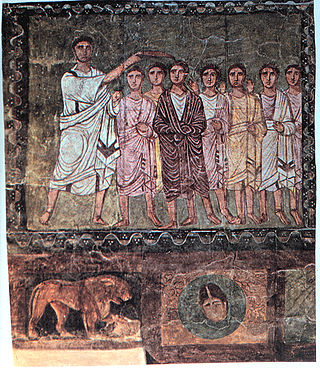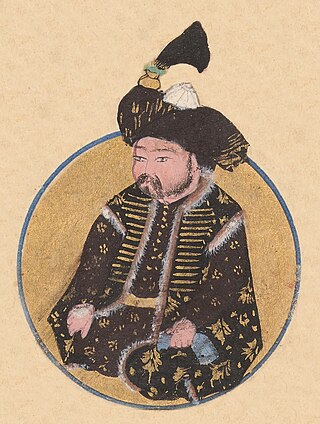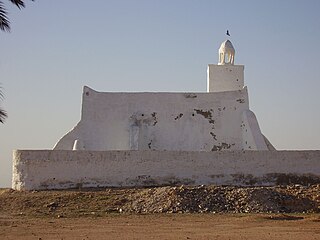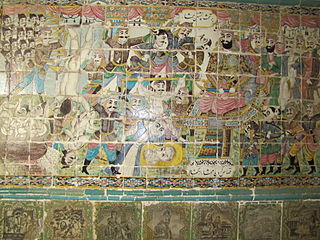
In Abrahamic religions, a messiah or messias is a saviour or liberator of a group of people. The concepts of mashiach, messianism, and of a Messianic Age originated in Judaism, and in the Hebrew Bible, in which a mashiach is a king or High Priest traditionally anointed with holy anointing oil.
Shia Islam is the second-largest branch of Islam. It holds that the Islamic prophet Muhammad designated ʿAlī ibn Abī Ṭālib as his successor (khalīfa) and the Imam after him, most notably at the event of Ghadir Khumm, but was prevented from succeeding Muhammad as the leader of the Muslims as a result of the choice made by some of Muhammad's other companions (ṣaḥāba) at Saqifah. This view primarily contrasts with that of Sunnī Islam, whose adherents believe that Muhammad did not appoint a successor before his death and consider Abū Bakr, who was appointed caliph by a group of Muhammad's other companions at Saqifah, to be the first rightful (rāshidūn) caliph after Muhammad. Adherents of Shīʿa Islam are called Shia Muslims.

Abu al-Abbas Abd Allah ibn Muhammad ibn Ali ibn Abd Allah, known by his laqab al-Saffah, was the first caliph of the Abbasid Caliphate, one of the longest and most important caliphates in Islamic history.

Abu Muslim Abd al-Rahman ibn Muslim al-Khurasani or Bihzādān Pūr Wandād Hormozd was a Persian general who led the Abbasid Revolution that toppled the Umayyad dynasty, leading to the establishment of the Abbasid Caliphate.

Husayn ibn Ali was an Alid political and religious leader. The grandson of the Islamic prophet Muhammad and a son of Ali ibn Abi Talib and Muhammad's daughter Fatima, as well as a younger brother of Hasan ibn Ali, Husayn is regarded as the third Imam (leader) in Shia Islam after his brother, Hasan, and before his son, Ali al-Sajjad. Being the grandson of the prophet, he is the member of the Ahl al-Bayt. He is also considered to be a member of the Ahl al-Kisa, and a participant in the event of the mubahala. Muhammad described him and his brother, Hasan, as the leaders of the youth of Paradise.

The Battle of Karbala was fought on 10 October 680 between the army of the second Umayyad caliph Yazid I and a small army led by Husayn ibn Ali, the grandson of the Islamic prophet Muhammad, at Karbala, Sawad.

The Ibadi movement or Ibadism is a branch of Islam. It has been called by some the third branch of Islam, along with Sunni Islam and Shia Islam. The followers of Ibadism are known as the Ibadis or, as they call themselves, The People of Truth and Integrity.

Al-Masih ad-Dajjal, otherwise referred to simply as the Dajjal, is an evil figure in Islamic eschatology who will pretend to be the promised Messiah and later claim to be God, appearing before the Day of Judgment according to the Islamic eschatological narrative. The word Dajjal is not mentioned in the Quran, but he is mentioned and described in the Hadith. Corresponding to the Antichrist in Christianity, the Dajjal is said to emerge out in the East, although the specific location varies among the various sources.
Rafida refers to those Shia Muslims who 'reject' the legitimacy of the caliphates of Abu Bakr, Umar, and Uthman, in favor of Ali ibn Abi Talib, the cousin and son-in-law of the Islamic prophet Muhammad.
ʿAbd Allāh ibn Sabāʾ al-Ḥimyarī, sometimes also called Ibn Sabāʾ, Ibn al-Sawdāʾ, or Ibn Wahb, was a 7th-century figure in Islamic history associated with a group of followers called the Sabaʾiyya (سبئية).

Al-Mukhtar ibn Abi Ubayd al-Thaqafi was a pro-Alid revolutionary based in Kufa, who led a rebellion against the Umayyad Caliphate in 685 and ruled over most of Iraq for eighteen months during the Second Fitna.
The Mahdi is a prominent figure in Islamic eschatology who is believed to appear at the End of Time to rid the world of evil and injustice. He is said to be a descendant of Muhammad, who will appear shortly before Jesus and will lead the Muslim Ummah to rule the entire world.
Shaykh Tusi, full name Abu Ja'far Muhammad ibn al-Hasan al-Tusi, known as Shaykh al-Ta'ifah was a prominent Persian scholar of the Twelver school of Shia Islam. He was known as the "sheikh of the sect ", author of two of the four main Shi'i books of hadith, Tahdhib al-Ahkam and al-Istibsar, and is believed to have founded the hawza. He is also the founder of Shia jurisprudence.
The Kaysanites were a Shi'i sect of Islam that formed from the followers of Al-Mukhtar. They traced Imamate from Muhammad ibn al-Hanafiyyah and his descendants. The name Kaysaniyya was most likely derived from the name of Mukhtar's chief guard, Abu Amra Kaysan.
Dāwūd ibn ʿAlī ibn Khalaf al-Ẓāhirī was a Sunni Muslim scholar, jurist, and theologian during the Islamic Golden Age, specialized in the study of Islamic law (sharīʿa) and the fields of hermeneutics, biographical evaluation, and historiography of early Islam. He is widely regarded as the founder of the Ẓāhirī school of thought (madhhab), the fifth school of thought in Sunnī Islam, characterized by its strict adherence to literalism and reliance on the outward (ẓāhir) meaning of expressions in the Quran and ḥadīth literature; the consensus (ijmāʿ) of the first generation of Muhammad's closest companions (ṣaḥāba), for sources of Islamic law (sharīʿa); and rejection of analogical deduction (qiyās) and societal custom or knowledge (urf), used by other schools of Islamic jurisprudence. He was a celebrated, if not controversial, figure during his time, being referred to in Islamic historiographical texts as "the scholar of the era."
Shia Islam originated as a response to questions of Islamic religious leadership which became manifest as early as the death of Muhammad in 632 CE. The issues involved not only whom to appoint as the successor to Muhammad, but also what attributes a true successor should have. Sunnis regarded Caliphs as a temporal leaders,. To the Shiite, however, the question of succession is a matter of designation of an individual (Ali) through divine command. In the same way, Shias believed that each Imam designated the next Imam by the leave of God. So within Shia Islam it makes no difference to the Imam's position whether he is chosen as a Caliph or not.
Ziyād ibn ʿAbd Allāh ibn Yazīd ibn Muʿāwiya, commonly known as Abū Muḥammad al-Sufyānī was an Umayyad prince and a pretender to the Umayyad Caliphate, which had been overthrown by the Abbasid Caliphate in early 750. Abu Muhammad led a revolt against the Abbasids, but his forces were defeated and he fled to the Hejaz, where he was killed in the early part of the Abbasid caliph al-Mansur's reign.
The Yudghanites ("Al-Yudghaniyyah") were a Jewish sect named after its founder, Yudghan or Judah of Hamadan, a disciple of Abu Isa al-Isfahani.







